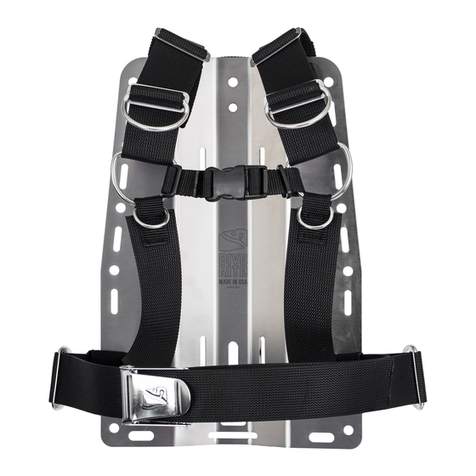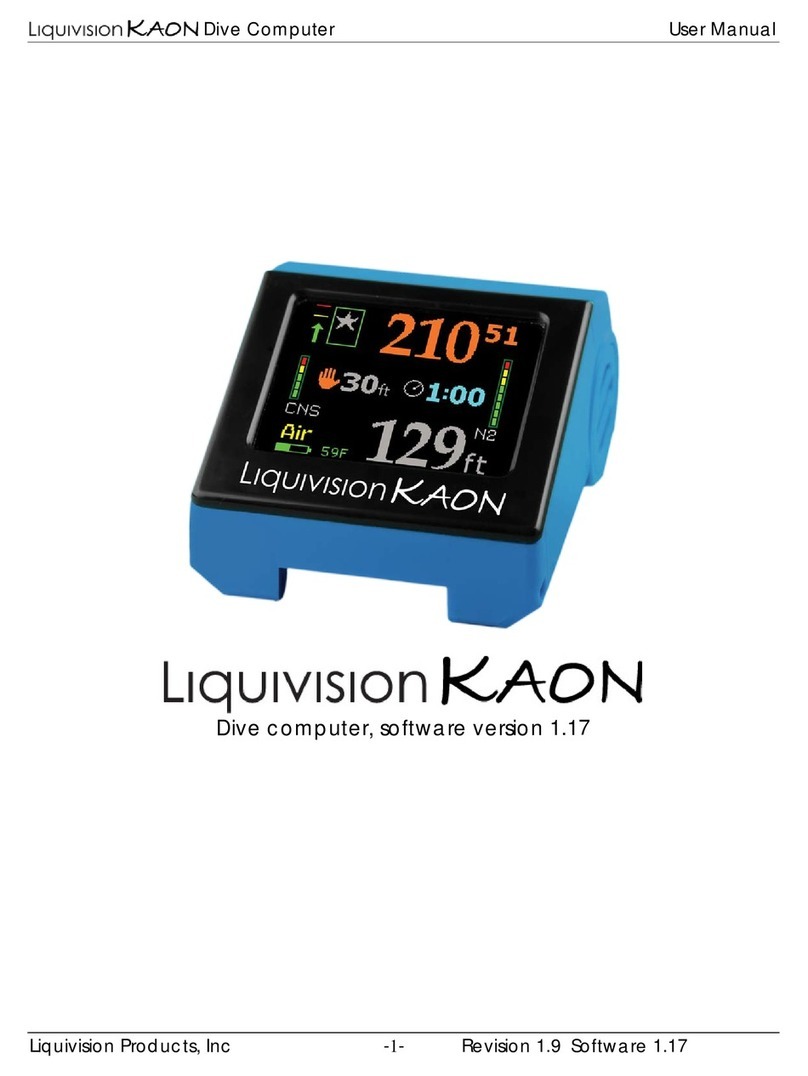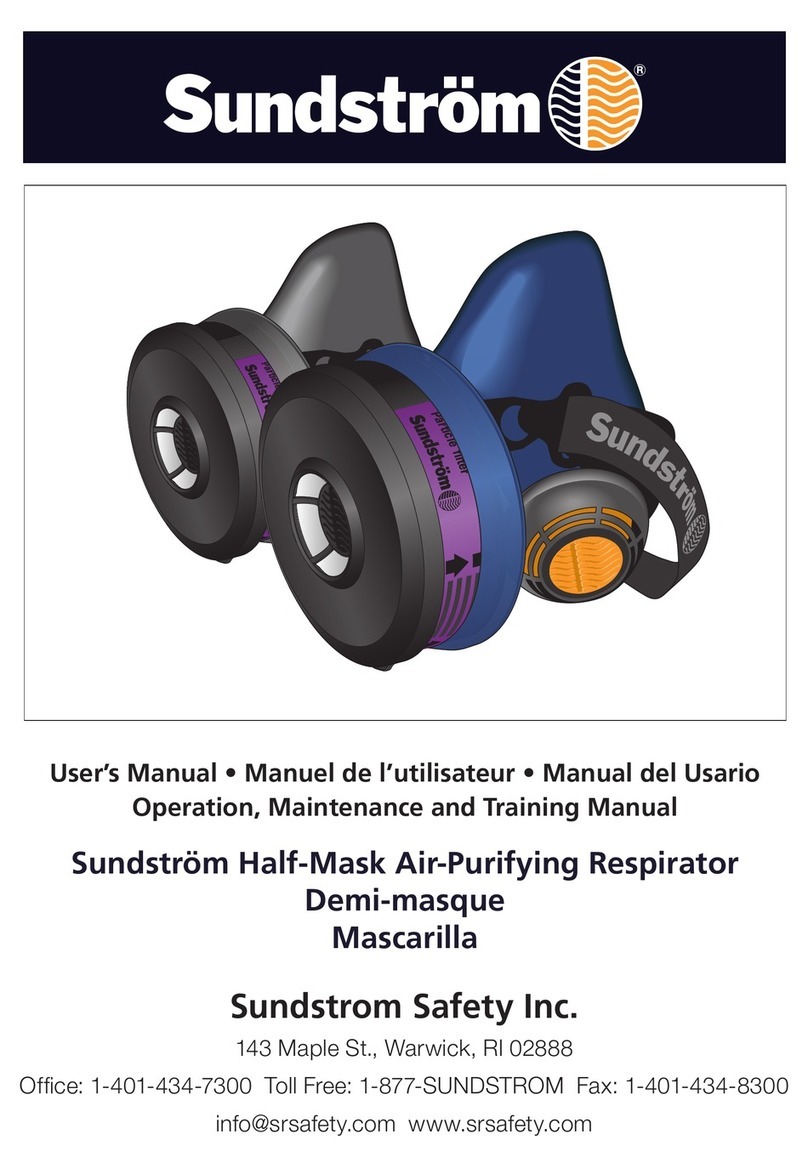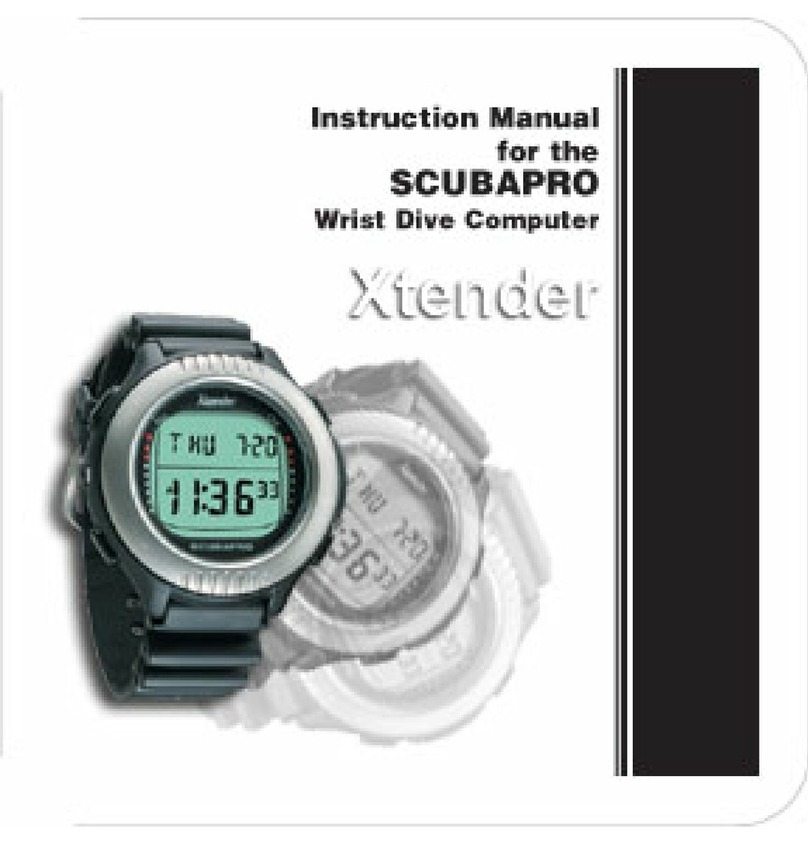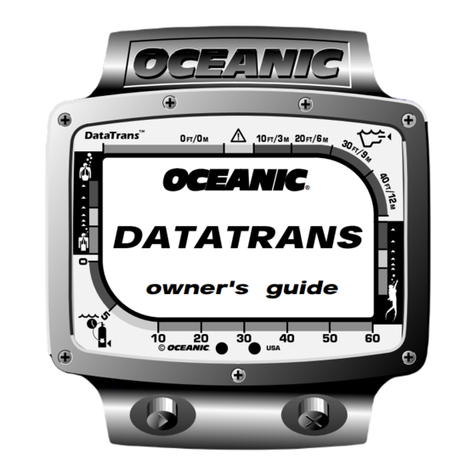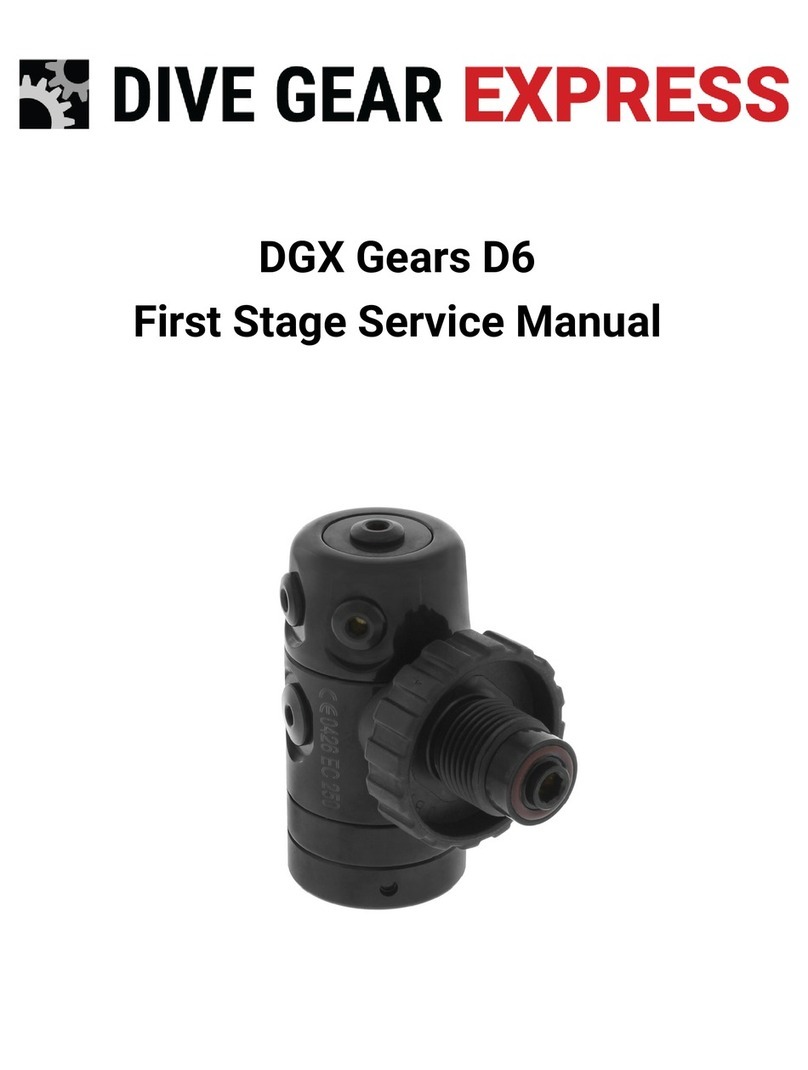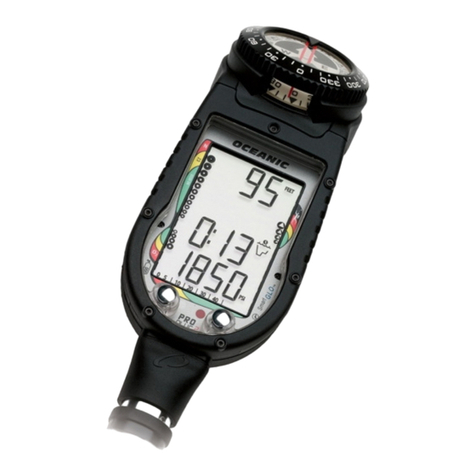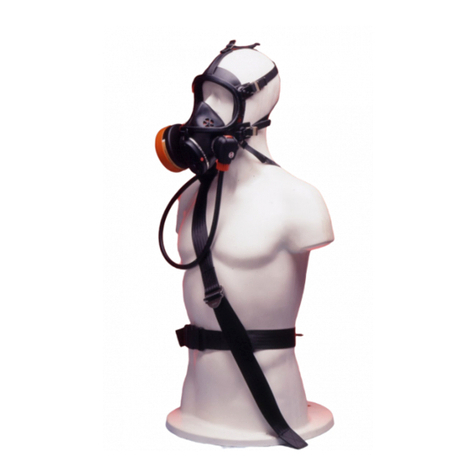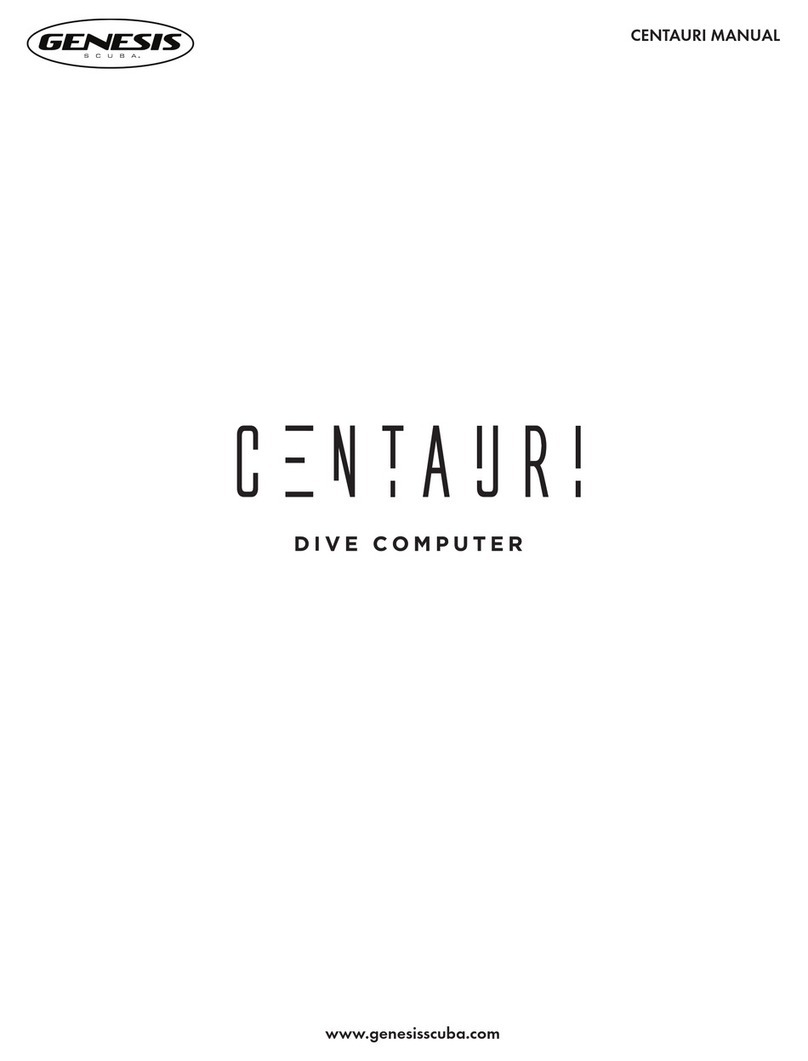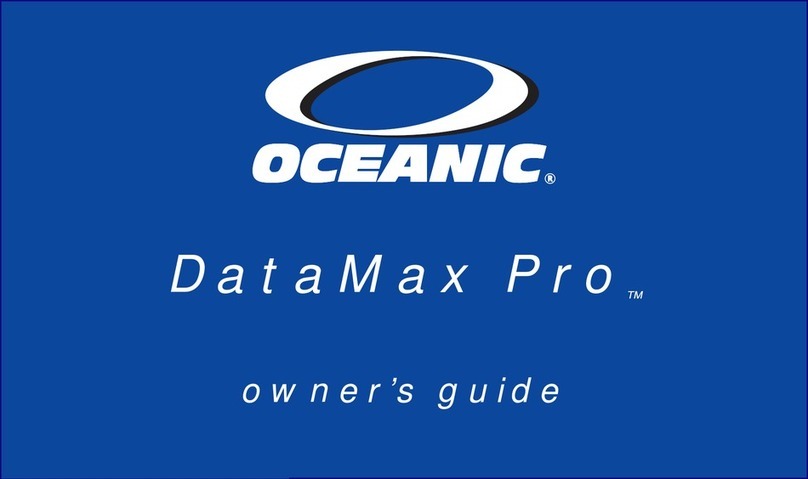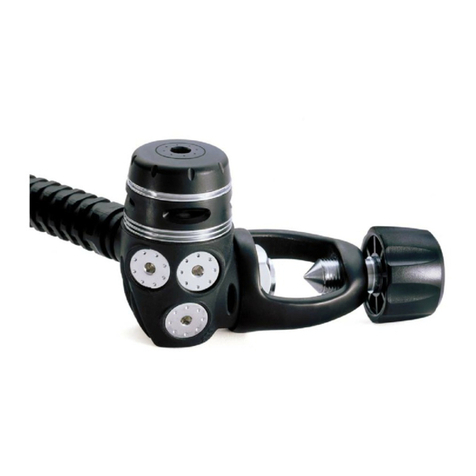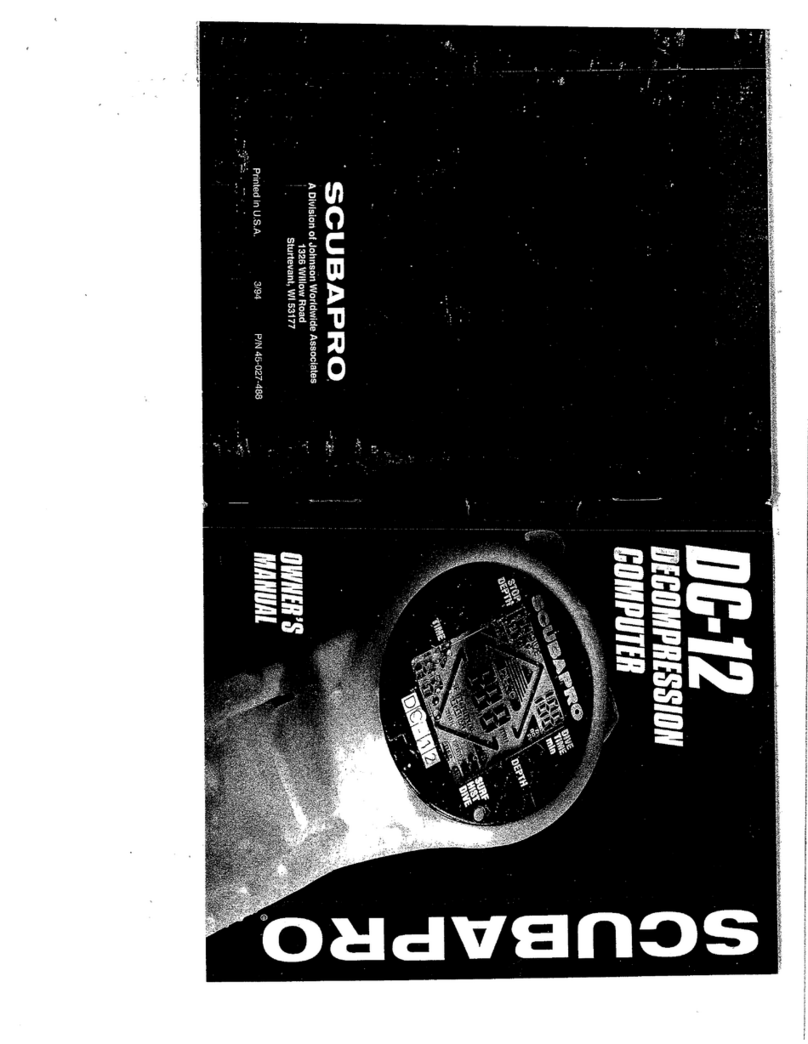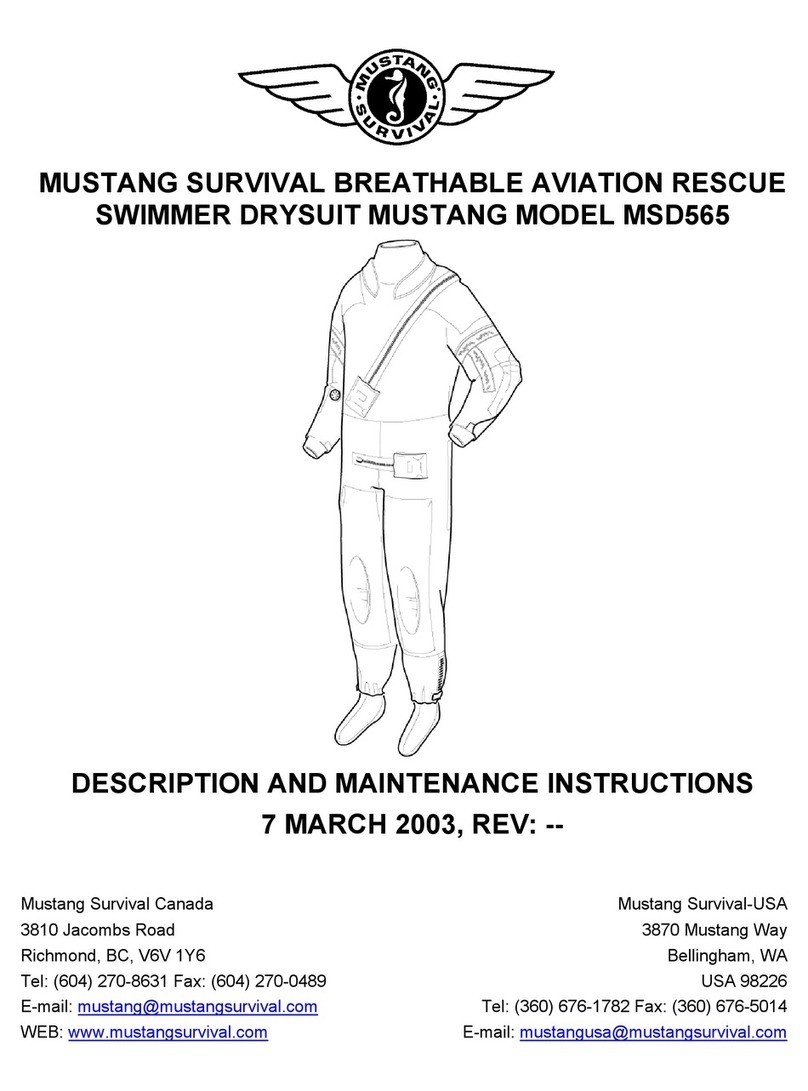Nitek Dive computer User manual

UserGuide
www.diverite.com
Dateofpurchase:
NiTekDiveComputer
NiTekDiveComputer


Content
NiTek Dive Computer User Manual i
DEVELOPED
BY
Dive Rite
175 NW Washington Street
Lake City, FL 32055
Phone: 386.752.1087
Fax: 386.755.0613
Web: www.DiveRite.com
COPYRIGHT
NOTICE Copyright © 1997-2004 Lamartek, Inc. dba Dive Rite
This manual is copyrighted by Lamartek, Inc. dba Dive Rite.
You may not reproduce, translate, transcribe, or transmit any
part of this manual without express, written permission from
Lamartek, Inc. dba Dive Rite.
WARRANTY
INFORMATION Dive Rite will—at its sole discretion—repair or replace NiTek
components proved to be damaged by faulty manufacture or
material, at no cost, for a period of up to one year (365 days)
from the date of purchase.
This warranty applies only to the original retail purchaser. It
does not cover commercial or rental use, nor does it extend to
units purchased from other than an authorized Dive Rite
dealer.
This warranty specifically excludes battery depletion or other
conditions resulting from misuse, negligence, alteration,
accident, or unauthorized repair.
To make a claim under this warranty, the owner must have
registered his/her warranty using Dive Rite’s website
(www.diverite.com). He or she must then return the damaged
items to Dive Rite, along with a copy of the original purchase
invoice or receipt. No warranty service will be performed for
other than registered owners.
This warranty becomes void if NiTek components are
damaged by anything other than normal recreational diving
use, or if they have been serviced or repaired by other than
authorized Dive Rite dealers.
Repairs made under this warranty will not extend the warranty
period.
All further claims, especially for damage after diving accidents,
are excluded from coverage under this warranty.
Dive Rite has no obligation to honor any extension of this
warranty.
This warranty is in lieu of all other warranties, expressed or
implied. No other person or representative is authorized to
assume for Dive Rite any other liability in connection with the
sale of this product.

Content
ii NiTek Dive Computer User Manual
Table of contents
Chapter 1 Introduction •1
Overview •2
Features and functions •3
Specifications •5
Warnings •6
Chapter 2 Using the NiTek •9
Getting started •10
Accessing display modes and screens •11
Surface mode •12
Dive plan mode •14
Understanding FO2 default •17
Dive mode •19
Surface mode (upon surfacing from a dive) •27
Log mode •29
Profile mode •31
PC transfer mode •32
Altitude operation •34
NiTek mode flow chart •36
Chapter 3 Care and maintenance •37
Proper handling techniques •38
Low battery warning •40
Index •41

NiTek Dive Computer User Manual 1
Chapter 1
Introduction
Summary
This chapter provides an overview of the NiTek, lists the
NiTek’s features and functions, and covers warning information
that should be read before using your NiTek.
Content Overview •2
Features and functions •3
Specifications •5
Warnings •6
When diving… •7

Introduction
2NiTek Dive Computer User Manual
Overview
Congratulations on your purchase of the NiTek dive computer.
The NiTek is a sophisticated and comprehensive dive computer
that was designed to offer you the latest in dive computer
technology, safety, and reliability.
The NiTek dive computer is a multifunctional computer for
recreational diving, providing information on depth, dive times,
no-decompression and decompression times, and nitrogen and
oxygen absorption and elimination during all dive phases,
including ascent, surface interval times, and subsequent dives.
This information is displayed on an easy-to-read display,
providing simple and direct communication between the diver
and the computer. With an easy-to-read display, the diver has no
problem following and reading the displayed information.
The NiTek comes standard with a number of modes, including a
time mode, dive set mode, dive plan mode, log mode, profile
mode, PC transfer mode, and dive mode.
Note: It is extremely important that you carefully read and
understand this manual. Make sure you fully understand how the
NiTek operates before diving with it.
This manual has been divided into three chapters:
•Introduction: Covers the features and functions,
specifications, and warnings for the NiTek
•Using the NiTek: Covers the operation of each mode for the
NiTek
•Care and maintenance: Covers how to properly care for
and maintain the NiTek and change the battery

Introduction
NiTek Dive Computer User Manual 3
Features and functions
The NiTek incorporates a number of important modes and
features:
•The NiTek turns on automatically upon descent
•On the surface, the NiTek constantly displays a minimum of
date and time
•The NiTek uses easily accessible and highly reliable push
buttons instead of exposed electrical contacts
•The NiTek can be programmed to monitor exposure to either
air or a Nitrox mixture from EAN22 to EAN50 during a dive
•The NiTek is capable of functioning up to a depth of 328
feet (100 meters)
•The NiTek automatically adjusts for altitudes up to 19,685
feet (6,000 meters)
•The NiTek displays a variety of data underwater including:
time of day, current and maximum depths, no-
decompression dive time elapsed and remaining, and water
temperature
•The NiTek displays data specifically related to the use of
Enriched Air Nitrox (EANx) including: fraction of oxygen
(FO2) setting, partial pressure of oxygen (PO2), and an
oxygen limit index (OLI) representing the cumulative effect
of a diver’s exposure to elevated PO2s (the theoretical “CNS
clock”) as a bar graph
•Through a combination of audible and visible alarms, the
NiTek alerts the diver to a number of possibly hazardous
situations including: violation of ascent rate, no-
decompression state, and whether mandatory decompression
stops are necessary or if the diver has ascended above a
mandatory stop ceiling. Nitrox specific warnings occur when
the diver approaches or exceeds a limiting PO2 of 1.6
atmospheres, and when cumulative exposure to elevated
PO2s exceeds recommended limits.
•The NiTek can be programmed to display data in Imperial or
metric units

Introduction
4NiTek Dive Computer User Manual
•Special mode indicators make it easy to determine what
display mode or screen you are in at any time
•The NiTek’s memory capability enables it to hold and
display log data on up to 10 dives
•Detailed dive-profile information is stored for each dive
through a one-minute sample interval
•Dive data can be uploaded and stored in a dive log format on
a desktop or laptop computer using the NiTekLogic™
software and optional PC interface
•The NiTek can calculate decompression stop requirements
for stops as deep as 49 feet (15 meters)

Introduction
NiTek Dive Computer User Manual 5
Specifications
Algorithm: Buhlmann ZH-L16
Sample tissues: 9
Tissue half-lives: from 5 to 640 minutes
Size and weight
Diameter: 2.5 in (62 mm)
Height: 1.0 in (25 mm)
Weight: 4 ounces (115 g)
Display face
Low battery indicator
Two user buttons
Water immersion switch
Depth sensor
Measuring range: 0 to 328 feet (0 to 100 m) measured every second
Accuracy: +/-3% + 2 feet (0.5 m)
Surface interval time: from 0 to 48 hrs
Diving time: from 0 to 599 minutes
Ascent rate warning: 26 to 52 feet per minute (8 to 16 m)
Thermometer
Measuring range: 23 °F to 104 °F (-5 to 40 °C)
Accuracy: +/-4 °F (2 °C)
Measurement interval: Every minute
Clock
Accuracy: +/-30 sec on average per month
24-hour display
Altitude
Altitude function monitoring: from 0 to 19,685 feet (6,000 m)
measured every 10 minutes
Accuracy: +/-800 feet (250 meters)
Battery
Li/MnO2 CR 2032 3V button battery
Average battery life: About 3 years (50 dives/year)
Replacement: User replaceable or return to manufacturer
Breathing gas
O2 setting range: 21 to 50 percent
O2 setting: 1% increments
Dive log
Dive logging: Maximum of 10 dives
Profile logging: Maximum of 10 dives
Profile sampling rate: 1 minute

Introduction
6NiTek Dive Computer User Manual
Warnings
This information has been developed for your safety. Please read
and understand this manual completely before using your NiTek
dive computer.
Important safety information:
•Before using your NiTek, it is extremely important that you
read the following points—as well as similar warning and
caution notices that appear throughout this manual. Failure
to do so could result in damage to or loss of equipment,
serious personal injury, or death.
•The NiTek is designed for use by certified divers who have
maintained a sufficient level of knowledge and skill
proficiency through a combination of formal training,
ongoing study, and experience. It is not intended for use by
persons who lack these qualifications and thus, may not be
able to identify, assess, and manage the risks scuba diving
entails. Use of the NiTek in conjunction with Enriched Air
Nitrox (EANx) requires that divers be trained and certified
for Nitrox diving.
•The NiTek is not intended for use by commercial or military
divers whose activities may take them beyond the commonly
accepted depth limits for recreational or technical diving.
•Although the NiTek is capable of calculating decompression
stop requirements, users must remember that dives requiring
mandatory stage decompression carry substantially greater
risk than dives made well within no-decompression limits.
•The NiTek is designed for use by one diver at a time. Divers
should not share a single NiTek—or any other dive
computer—on the same dive. Additionally, no diver should
lend their NiTek to anyone else until it calculates that no
measurable residual nitrogen remains after previous dives
and no longer displays the “desaturation time” indicator
while in time mode. Further, no diver should use their NiTek
for repetitive dives—unless that same properly functioning
NiTek has accompanied them on all previous dives in the
same repetitive dive series and is thus, accurately monitoring
the diver’s total exposure to oxygen and nitrogen.

Introduction
NiTek Dive Computer User Manual 7
•Neither the NiTek—nor any other dive computer—
physically measures the amount of nitrogen present in body
tissues or the rate at which nitrogen is being absorbed or
released. The NiTek monitors depth and time, and uses this
data to work a mathematical formula designed to emulate
how individuals in good general health and whose physical
characteristics do not place them among those at higher risk
of decompression illness (DCI) are assumed to absorb and
release nitrogen from body tissues. Thus, the NiTek cannot
compensate for factors such as age, obesity, dehydration,
cold, or exertion, which experts believe place divers at
greater risk of DCI. If these, or similar factors apply to you,
use the NiTek—and other dive computers or dive tables—
with even greater caution.
•Little is known regarding the exact nature and causes of
decompression illness (also known as decompression
sickness, DCI, or DCS). Susceptibility to DCI may vary
substantially from person to person and from day to day.
Neither the NiTek—nor any other dive table or computer—
can guarantee that you will not suffer decompression illness.
Even though you use these items correctly, you may still
suffer DCI. Use your NiTek conservatively and in
conjunction with other dive planning devices, such as dive
tables. Do not rely on the NiTek, or any similar device, as
your sole means of avoiding decompression illness.
When diving…
•Do not “push” the no-decompression limits (NDLs). Make
safety stops before ascending. If you exceed the no-
decompression limits, check your breathing gas supply at all
stop depths.
•The NiTek does not monitor breathing gas supply. You must
monitor this yourself, on every dive, using a submersible
pressure gauge or equivalent device.
•Do not rely solely on this or any other dive computer. Take a
back-up dive computer or dive tables (along with a separate
means of monitoring depth and dive time).
•Be aware that the NiTek makes assumptions regarding
residual nitrogen based on altitude settings. Avoid making

Introduction
8NiTek Dive Computer User Manual
abrupt changes in altitude following a dive, as doing so may
be very dangerous.

NiTek Dive Computer User Manual 9
Chapter 2
Using the NiTek
Summary
This chapter provides topics about using, setting, and
understanding each of the modes and options of the NiTek.
Content Getting started •10
Accessing display modes and screens •11
Button operation •11
Surface mode •12
Entering surface mode from another
mode •12
Setting the time and date •13
Setting the computer for metric or Imperial
operation •13
Dive plan mode •14
Setting the FO2 gas mix percentage •15
Understanding FO2 default •17
Dive mode •19
Primary underwater screen •19
Secondary underwater screen •20
Warnings while in diving mode •21
Surface mode (upon surfacing from a dive) •27
Log mode •29
Profile mode •31
PC transfer mode •32
Before transferring the dive log •32
Altitude operation •34
NiTek mode flow chart •36

Using the NiTek
10 NiTek Dive Computer User Manual
Getting started
The NiTek has many modes and screens and a number of options
that can be changed depending on your dive location and profile.
The following is a checklist of general things that you should
pay attention to before, during, and after a dive.
Before a dive
•Check that the proper time and date are set. If you traveled,
your NiTek may be set to your home time zone.
•Check that the proper mix is set
•Make sure that you review the dive plan mode for maximum
depths and times for the mix you are using
During a dive
•Monitor the NiTek throughout your dive for depth and time
•Monitor the nitrogen and oxygen loading bar graphs
•Pay attention to any alarms, such as an ascent rate warning
•Follow the no-decompression limits or complete the required
decompression displayed and perform the necessary safety
stop
After a dive
•Monitor surface interval time if making another dive
•Follow the no-fly requirements
•Review your dive using the log mode and profile mode
•Download the dive log to your PC if you have the optional
PC interface

Using the NiTek
NiTek Dive Computer User Manual 11
Accessing display modes and screens
There are some display modes that the NiTek enters and/or exits
automatically. For example, by taking the NiTek underwater, the
dive mode automatically turns on. Upon surfacing, the NiTek
automatically enters the surface mode.
Accessing other modes or screens requires the use of the NiTek’s
buttons.
Button operation
The NiTek has two buttons (A and B), which are used to access
the different modes and screens. To use the buttons, simply press
the button once or hold the button down depending on what you
are trying to do. The correct procedure to use is clearly defined
in each topic throughout the manual.
Button A
Button B
The front of the NiTek, showing the two buttons that are used to
access and setup the different modes and screens

Using the NiTek
12 NiTek Dive Computer User Manual
Surface mode
Surface mode is the NiTek’s default mode. The computer returns
to this mode automatically upon surfacing from a dive and from
other modes when a period of time has passed without the
buttons being pressed.
The arrow at the bottom of the display points to SURF.
1
2
3
(1) Date: This is the date in month and day format.
(2) Time: This is the time of day in 24-hour (military) format.
(3) Altitude: This is the current altitude you are at. See “Altitude
operation” for more information.
The NiTek may display additional information concerning
exposure to nitrogen and oxygen, desaturation time, and surface
interval time. These items are covered in “Surface mode (upon
surfacing from a dive).”
Setting the time and date
Setting the time and date is done through the surface mode. You
can enter or change the year, month, day, hours, minutes, and
seconds in this mode.
To set the time and date:
1. Press buttons A and B simultaneously for five seconds.
The “hour” field flashes.
2. Press button B to set the hour or press button A to go to
another field, such as minutes.

Using the NiTek
NiTek Dive Computer User Manual 13
3. Using button’s A and B, set the year, month, day, hour,
minutes, seconds. The time is based on a 24-hour format.
For example, 1:00 PM would be 13:00.
4. When finished, press button A to return to surface mode.
Setting the computer for metric or Imperial
operation
The NiTek can calculate and give you values in Imperial units or
metric units. When in Imperial, depth values are expressed in
feet and temperatures are expressed in Fahrenheit (°F). When in
metric, depth values are expressed in meters and temperatures
are expressed in Celsius (°C).
To set for metric or Imperial operation:
1. Press buttons A and B simultaneously for five seconds to
enter time set mode.
2. Press and hold buttons A and B simultaneously for 30
seconds.
The computer changes to either feet (ft) or meters (m).
3. When finished, press button A to scroll through the time and
date settings until the computer returns to the surface mode.

Using the NiTek
14 NiTek Dive Computer User Manual
Dive plan mode
Dive plan mode enables you to determine how long you can stay
at various depths while remaining within the no-decompression
limits. The no-decompression time limits are based on the gas
percentage that is set. If you are making a dive within 24 hours
of a previous dive, the no-decompression time limits are based
on the residual nitrogen remaining.
The two most important values that are displayed on the screen
in dive plan mode are the depth and no-decompression time limit
for the gas percentage that is set.
1
2
(1) Depth: When you first enter dive plan mode, the initial depth
displayed is 30 feet (9 meters). You can advance the depth in 10-
foot (3 meter) increments. Fourteen different dive plan depth
increments can be displayed to a maximum depth of 157 feet (48
meters).
(2) No-decompression limit (NDL): Depending on the depth
displayed and the current FO2 setting, the available no-
decompression limit, up to a maximum of 200 minutes, is
displayed. If the computer is in FO2 default, a series of
horizontal lines appears.
If the NiTek calculates that there is residual nitrogen present
from previous dives, the available no-decompression limits are
shorter. Depending on how much residual nitrogen is present, no
NDL time may be displayed for some deeper depths. If this takes
place, a series of horizontal lines are displayed. Similarly, for
combinations of depth and FO2 that would cause a diver to

Using the NiTek
NiTek Dive Computer User Manual 15
exceed a limiting PO2 of 1.6 atmospheres, a series of horizontal
lines appears in place of the no-decompression limit.
To enter dive plan mode:
1. Press button A.
The arrow at the bottom of the display points to PLAN.
2. Press button A to increment the depth.
The no-decompression time limits change automatically
based on the depth.
3. When finished, press and hold button A for three seconds to
return to surface mode.
WARNING: Do not plan dives to depths deeper than those for
which the NiTek is capable of displaying an available no-
decompression limit. Doing so could cause you to exceed the no-
decompression limits or a limiting PO2 of 1.6 atmospheres. This
may increase your risk of decompression illness or CNS oxygen
toxicity and can lead to serious personal injury or death.
Setting the FO2 gas percentage
While in dive plan mode, you can set the FO2 gas percentage
that you are going to use on your dive. The FO2 gas percentage
can be set for air to 50 percent oxygen.
Note: It is important to check the FO2 gas percentage prior to
every dive to make sure the gas percentage programmed matches
the gas percentage you are using for the dive.
When you enter the FO2 set mode, the depth and NDL disappear
and the FO2 value flashes.

Using the NiTek
16 NiTek Dive Computer User Manual
To set the FO2 gas percentage:
1. Press buttons A and B simultaneously for six seconds.
The FO2 gas percentage flashes.
2. Press and release button B to increase the percentage.
Press and hold button B to increase the percentages rapidly.
3. When finished, press button A to return to dive plan mode.
4. To return to surface mode, press button A for three seconds.
Note: If a Nitrox mixture is set, the NITROX symbol is
displayed at the bottom of the screen.
Table of contents
Other Nitek Diving Instrument manuals



